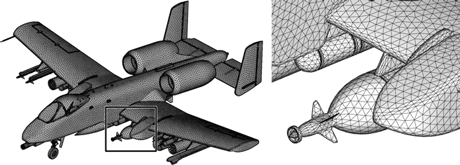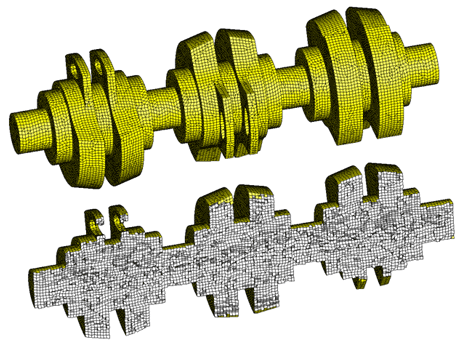The project GoodShape, funded by the European Research Council ("Starting Grant Project"), aims at advancing the state of the art in 3D meshing.
Mesh generation plays a central role in numerical simulation, used to predict the behaviour of engineering and physical systems under various conditions. Numerical simulation is a key to the competitiveness of many companies. It has the following benefits:
- Reducing the development cost of complex systems: in the aircraft industry, numerical simulation is an efficient alternative to wind tunnel experiments. In the automobile industry, numerical crash test simulation is clearly much cheaper than its real-world counterpart;
- Optimizing production and reducing energy consumption: in the oil and gas industry, the production of oil is influenced not only by the placement of the wells but also by a large set of parameters associated with each well. Numerical flow simulation allows evaluation of the influence of each parameter and thus optimization of the well's production of oil. More generally, it also allows managers to significantly optimize and reduce the consumption of energy in a wide range of systems, from small devices to large industrial infrastructures;
- Fault prevention and maintenance: by simulating the long-term evolution of a system it is possible to better understand its aging process and forecast the apparition of faults. Thus it is an efficient way of designing maintenance plans for complex systems.
For all the application domains mentioned above, the quality of the computerized representation - a 3D mesh - plays a central role in the accuracy and efficiency of numerical simulations. By “quality”, engineers mean that the elements that compose the 3D mesh need to both satisfy some geometric constraints and adaptively capture the small features of the data (see Figure 1). This is a key aspect for the cited application domains. For instance, the so-called "hex dominant meshes" (Figure 2), crucial for some simulations, are notoriously difficult to generate and can require weeks (or even months) of user interaction [1].
Project GOODSHAPE takes a new approach to 3D mesh generation, based on the theory of numerical optimization. The optimal mesh generation algorithm developed in the frame of the GOODSHAPE project globally and automatically optimizes the mesh elements with respect to geometric constraints. The mathematical foundations of this algorithm, i.e. the minimization of a smooth energy function, result in practice in a faster algorithm, and - more importantly - in a higher flexibility. For instance, it will allow automatic generation of the aforementioned "hex-dominant" meshes [2],[3].
The GOODSHAPE project currently explores the industrial potential of the algorithm and conducts early technology testing in the domain of oil and gas (see Figure 3) with the GOCAD consortium, and in the domain of Computer Aided Engineering. In the long term, the goal is to push the limits of mesh generation, in terms of quality (global optimization), flexibility (resistance to error in the data, geometric constraints, hex-dominant meshing) and efficiency (parallel, multicore implementation).

Figure 1: Mesh repair and adaptive re-meshing (data: Distene)

Figure 2: Hex-dominant mesh with Lp Centroidal Voronoi Tesselations (data: CM2 Computing Objects)

Figure 3: Re-meshing geological faults (data: Gocad consortium and ParadigmGeo)
Links:
Project GOODSHAPE: http://alice.loria.fr/goodshape
GOCAD consortium: http://www.gocad.org
References:
[1] Matt Staten's presentation on hex meshing (Defense & Space Sandia Labs): www.scribd.com/doc/52824132/Why-Is-Hex-Meshing-So-Hard
[2] Lp Centroidal Voronoi Tesselations, B. Levy and Y. Liu,
ACM Transactions on Graphics, special issue SIGGRAPH conf. proc., 2010; http://alice.loria.fr/index.php/
publications.html?redirect=0&Paper=LPCVT@2010
[3] Procédé de generation de maillages hex-dominants, French Patent Application, FR 10/02920 (filed 07/09/10), 2010
Please contact:
Bruno Levy, Inria, France
E-mail:










